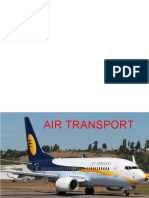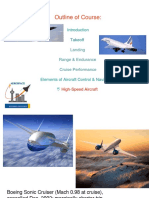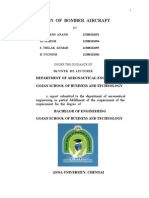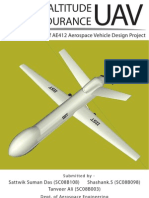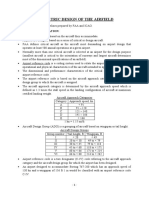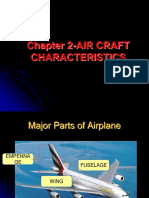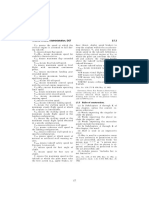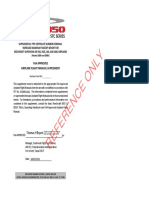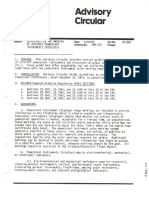Conceptual Aircraft Design: Operational Specifications
Conceptual Aircraft Design: Operational Specifications
Uploaded by
ayeshaCopyright:
Available Formats
Conceptual Aircraft Design: Operational Specifications
Conceptual Aircraft Design: Operational Specifications
Uploaded by
ayeshaOriginal Description:
Original Title
Copyright
Available Formats
Share this document
Did you find this document useful?
Is this content inappropriate?
Copyright:
Available Formats
Conceptual Aircraft Design: Operational Specifications
Conceptual Aircraft Design: Operational Specifications
Uploaded by
ayeshaCopyright:
Available Formats
FLIGHT VEHICLE DESIGN (10AE81) Unit 1
CONCEPTUAL AIRCRAFT DESIGN
Operational specifications:
Military aircraft specifications are often derived using operational research
techniques, but include significant input from pilots and engineers.
1. Modes of operation:
The need exists for a close air support capable of operating in support of ground
troops in the vicinity of the forward edge of battle area (FEBA). Three modes of
operation are required.
Autonomous mode:
In this mode the aircraft is required to operate some 100 km behind the FEBA. The
targets will be first and second echelon troops - in particular main battle tanks, armored
fighting vehicles, armored personnel carriers and their support vehicles in daylight hours.
Forward air control mode:
In this mode, the aircraft is directed on to targets by a forward air control aircraft
(FAC). It is envisaged that the FAC aircraft would carry the complex electronic systems
required to direct, identify and mark targets.
Ground control mode:
In this mode the aircraft is directed onto targets by ground forces.
2. Mission radius:
The radius of action of the aircraft should be 500 km at 3.5 km altitude, optimum
speed with a 15 min loiter/search time and a 10% fuel reserve. These figures are based
upon the following mission at the specification payload:
(i) Cruise at optimum speed at low level 300 km to FEBA.
(ii) Accelerate to Mach Number (M) 0.8 at a height of 100 m and carry out mission. (100
km penetration to target.)
(iii) Optimum speed cruise at low level 300 km back to base.
3. Take-off and landing performance:
The aircraft should take off from semi-prepared strips in a distance of 880 m over
a 15 m obstacle. Landing ground distance should be 500 m.
4. Performance:
The following performance figures are required:
(i) Maximum speed: 0.8 at sea level (SL) with a specified payload (2.3.5 below); 0.9 at SL
with two advanced short-range air-to-air missiles (ASRAAM) alone.
(ii) Maximum operational height: 3500 m.
Miss. Pavana K. Asst. Prof. SIT Page 1
FLIGHT VEHICLE DESIGN (10AE81)
(iii) Maximum-sustained g loading: 4g at specified payload at M 0.8 at SL.
5. Weapon loads:
Possible weapon loads include:
(i) Six 277 kg cluster bombs + two ASRAAM + gun + ammunition (specified payload).
(ii) Eight 500 kg low drag bombs + two ASRAAM + gun.
(iii) One JP233 fuselage store of2335 kg + two ASRAAM + gun.
(iv) Six short range air to ground guided missiles + two ASRAAM + gun.
6. Avionics fit:
The avionics fit comprises the following systems:
Integrated communication, navigation and identification system. Inertial
navigation system.
Controls and displays.
Radar altimeter.
Digital computers.
Weapon management and interface unit (IFU). Tail warning (0.15 m diameter
antenna). Radar warning receiver.
2-18 GHz jammer.
Chaff and flare dispensers. Ground attack, laser range finder. Forward-looking
infra-red (FUR).
2.4 Airline specification for a ISO-seat airliner
This is an amalgamation of US and European specifications that were current in
mid-1980s, and led to the MD80 and Airbus A320-type designs.
Mission Requirements:
To balance the different aspects of the total performance while trying to optimize
based on well-defined mission requirements. There are many performance aspects that
can be specified by the mission requirements. These include
The aircraft purpose or mission profile;
The type(s) and amount of payload;
The cruise and maximum speeds;
The normal cruise altitude;
The range or radius with normal payload;
The endurance;
The take-off distance at the maximum weight;
The landing distance with 50 percent of the maximum fuel weight;
The purchase cost; and
Other requirements considered important.
Miss. Pavana K. Asst. Prof. SIT Page 2
FLIGHT VEHICLE DESIGN (10AE81)
1. Aircraft Purpose:
The starting point for any new aircraft is to clearly identify its purpose. With this,
it is often possible to place a design into a general category. Such categories include
combat aircraft, passenger or cargo transports, and general aviation aircraft. These may
also be further refined into subcategories based on particular design objectives such as
range, take-off or landing distances, maximum speed, etc, The process of categorizing is
useful in identifying any existing aircraft that might be used in making comparisons to a
proposed design.
With modern military aircraft, the purpose for a new aircraft generally comes from
a military program office based on their requirements.
With modern commercial aircraft, a proposal for a new design usually comes as
the response to internal studies that aim to project future market needs. For example, the
specifications for the most recent Boeing commercial aircraft (B-777) were based on the
interest of commercial airlines to have a twin-engine aircraft with a payload and range in
between those of the existing B-767 and B-747 aircraft.
2. Payload:
The payload is what is carried on board and delivered as part of the aircraft’s
mission. Standard payloads are passengers, cargo, or ordnance, the first two are
considered nonexpendable payload because they are expected to be transported for the
complete duration or the flight plan. Military ordnance is expendable payload since at
some point in the flight plan it permanently leaves the aircraft. This includes bombs,
rockets, missiles, and ammunition for on-board guns.
For personal-or small general aviation aircraft, the payload includes the pilot as
well as passengers and baggage. For business, commuter, and commercial aircraft,
payload includes the passengers, baggage and cargo.
3. Cruise and Maximum Speeds:
The mission of an aircraft usually dictates its speed range. Propeller-driven
aircraft are usually designed to cruise at speeds between 150 to 300 knots. Jet powered
aircraft have higher cruise speeds that are normally specified in terms of Math number,
the typical cruise Mach number for business and commercial jet aircraft is from 0.8 to
0.85. This range of cruise speeds is close to optimum for maximizing the combination of
payload weight, range, and speed. The few supersonic commercial aircraft designs
(1) Have supersonic cruise speed as their principle design driver
(2) Sacrifice range and payload.
The cruise Mach number of the Concord is 2.02. It will carry 100 passengers with
a range of 3740 miles. Modern military jet combat and attack aircraft usually have a flight
plan that involves efficient cruise at high subsonic Mach numbers. This is usually in the
range from Mach 0.85 to 0.90.
Miss. Pavana K. Asst. Prof. SIT Page 3
FLIGHT VEHICLE DESIGN (10AE81)
4. Normal Cruise Altitude:
The cruise altitude is generally dictated by the cruise speed, propulsion system and
cabin pressurization. An aircraft with an unpressurized cabin would cruise no higher than
10,000 feet. With propeller-driven aircraft, turbo-charged piston engines can maintain a
constant horsepower up to an altitude of approximately 20,000 feet. Higher altitudes are
possible with turboprop aircraft, such as the Piper Cheyenne, Which have a maximum
ceiling from 35,000 to 41,000 feet. The decrease in air density with higher altitude lowers
the drag, so that for these aircraft, the cruise range increases with altitude.
At higher subsonic Mach number, the turbo jet engine gives the highest efficiency.
For subsonic turbo-jet aircraft, there is an optimum altitude where fuel consumption is a
minimum. This occurs at approximately 36000 feet. Therefore it is the best altitude for
the efficient long range cruise of turbo-jet powered aircraft.
5. Range:
The range is the longest distance the aircraft can fly without refueling. In a flight
plan, range refers to the distance travelled during the cruise phase.
The choice of the range is one, of the most important decisions because it has a
large effect on the aircraft take-off weight. An aircraft that is intended to fly across the
United States should have a minimum range of 2500 nautical miles. A range of 3500
nautical miles would be necessary for transatlantic flights from East coast U.S. cities to
coastal cities in Western Europe.
Shorter range transports that are designed to fly between major cities in a regional
area should have a minimum range of 500 nautical miles.
6. Endurance:
Endurance is the amount of time an aircraft can fly without refueling. With a
reconnaissance aircraft, endurance is one of the main design drivers, For a commercial
aircraft, a flight plan will include an endurance phase to allow for time that might be
spent in holding pattern prior to landing. For operation within the continental United
States commercial aircraft are required to be able to hold for 45 minutes at normal cruise
fuel consumption. For international operation, the required hold time is 30 minutes.
7. Take-off distance:
The total take-off distance consists of the length of a runway needed to accelerate,
lift and climb to a prescribed obstacle height. The obstacle height is 50 feet for military
and small civil aircraft. And 35 feet for commercial aircraft. The take-off distance that is
required to accomplish this depends on different factors in the design such as the thrust-
to-weight ratio, and the surface of the air field that affects the rolling friction of the
landing-gear wheels.
Different designs can fall into standard categories for take-off and landing. A
conventional take-off and landing (CTOL) aircraft has distance that arc greater than 1000
feet. A short take-off and landing (STOL) aircraft can take off and landing under 1000
Miss. Pavana K. Asst. Prof. SIT Page 4
FLIGHT VEHICLE DESIGN (10AE81)
feet. Both of these would have a ground roll portion during take-off and landing. A
vertical take-off and landing (VTOL) aircraft does not require a ground roll.
Personal and general aviation propeller-driven aircraft, which are intended to operate out
of smaller airport, need take-off distances of 1200-2000 feet. Larger twin engine propeller
commuter aircraft, which operate out of medium to large size airports, have take-off
distances from 3000- 5000 feet. Business and smaller Commercial jets have take-off
distances of 5000- 7500 feet, larger commercial jet transport aircraft require take-off
distances from 8000-11,000 feet. The lake-off distance is a function of the altitude of the
airport.
8. Landing distance:
The landing distance consists of the length of the runway needed to descend from
a specified height of 50 feet, touchdown, and break to a stop, Factors that affect the
landing distance are the maximum lift-to-weight and the surface of the air field, which
affects the landing-gear wheels braking friction coefficient. The lift-to-weight ratio
directly affects the slowest (stall) speed at which the aircraft can fly.
For commercial aircraft, the landing distance is determined with half of the fuel
weight at take-off remaining and with an additional two-thirds distance to account for
pilot variability. Even with these measures, the landing distances are almost always less
than the take-off distances.
9. Purchase Cost:
The purchase cost of an aircraft involves the costs incurred in the research,
development, test, and evaluation (RDT&E) phase of the new aircraft design, and the
acquisition (A) or production cost of customer order aircraft. The cost estimates are based
on “cost estimating relationships” or CERs, this is depends on structure weight. Therefore
heavier aircraft will cost more than smaller, lighter aircraft. Similarly, aircraft with higher
cruise speeds are expected to cost more than slower aircraft.
10. Federal aviation regulations:
Any aircraft design must consider standards and regulations that are set by
government association. Civil aircraft designed, built, and operated in the United States
must satisfy the provision of the Federal Aviation Regulations (FARs). The FARs are
continually being updated to incorporate additional requirements that come about due to
increased time and experience with existing aircraft. Electronic listing of the FARs can be
obtained through a World Wide Web link to the Flight Standards Service of the U.S.
Federal Aviation Association (FAA).
Sections of the FARs that are of particular interest to designers are Air Worthiness
Standard, General operating and Flight Rules, and Operations. Air Worthiness standards
parts 23 and 25 in particular define different categories of aircraft based on such
characteristics as number of passenger and maximum take-off weight. These categories
are important in making comparison to other aircraft with regard to flight performance, or
other design drivers.
Miss. Pavana K. Asst. Prof. SIT Page 5
You might also like
- Bombardier CRJ Series Normal Checklist For Flight CrewDocument4 pagesBombardier CRJ Series Normal Checklist For Flight CrewGourav DasNo ratings yet
- CL604 QRH HandoutDocument2 pagesCL604 QRH HandoutMartin MoyanoNo ratings yet
- 2300AD Ships of The French ArmDocument210 pages2300AD Ships of The French ArmAlain Breton100% (1)
- 737 Performance Reference Handbook - EASA EditionFrom Everand737 Performance Reference Handbook - EASA EditionRating: 4.5 out of 5 stars4.5/5 (3)
- Jesse Mills - Fse100 - Week 15 - Disaster Relief Final Project Report FinalDocument37 pagesJesse Mills - Fse100 - Week 15 - Disaster Relief Final Project Report Finalapi-539509394No ratings yet
- Flight Factor A350 ManualDocument218 pagesFlight Factor A350 Manualvasilisnikon90% (20)
- Aircraft Weight and Balance Handbook: FAA-H-8083-1AFrom EverandAircraft Weight and Balance Handbook: FAA-H-8083-1ARating: 5 out of 5 stars5/5 (1)
- Fixed Wing Design Paper Ae 6343 PDFDocument30 pagesFixed Wing Design Paper Ae 6343 PDFΙωάννης Γεωργίου ΜάντηςNo ratings yet
- Sopm 1755 001 Rev15 FullDocument367 pagesSopm 1755 001 Rev15 FullCarlos Arturo Lopez Yañez100% (1)
- ADP I Lab Manual FinalDocument52 pagesADP I Lab Manual Finalसंकेत कलगुटकरNo ratings yet
- ADP Lab ManualDocument34 pagesADP Lab ManualRevathiNo ratings yet
- Aircraft Design Project I AbiashokDocument74 pagesAircraft Design Project I AbiashokAbinayan EiswarasivajiNo ratings yet
- Aircraft DesignDocument33 pagesAircraft DesignRAHUL DHIMAN100% (2)
- Unit 4 Airport Engg. PPT TYDocument78 pagesUnit 4 Airport Engg. PPT TYAbhishek SinghNo ratings yet
- Aircraft Project 15 Passenger Business JetDocument50 pagesAircraft Project 15 Passenger Business Jetprakulmittal2No ratings yet
- Air Transport Air TransportDocument74 pagesAir Transport Air TransportJitendra Gurjar100% (1)
- Aiaa 2021 Graduate Team Aircraft Design RFP Modern Regional Jet FamilyDocument7 pagesAiaa 2021 Graduate Team Aircraft Design RFP Modern Regional Jet FamilyArman AsgharpoorNo ratings yet
- Lapangan Terbang 6Document47 pagesLapangan Terbang 6Hengky TernandoNo ratings yet
- High SpeedDocument48 pagesHigh SpeedmauryapiaeNo ratings yet
- 07 Chapter5Document19 pages07 Chapter5T macccNo ratings yet
- 2023-24-Heavy Lift RFPDocument6 pages2023-24-Heavy Lift RFPbasha.arshad.mullaNo ratings yet
- Cruise - MRC, LRC - Lecture #5Document60 pagesCruise - MRC, LRC - Lecture #5BruceNo ratings yet
- Request For Proposal: Austere Field Light Attack AircraftDocument6 pagesRequest For Proposal: Austere Field Light Attack AircraftDANIEL ENRIQUE ALDANA LOPERANo ratings yet
- Aircraft Desing Task-1 and 2 Report FormatDocument6 pagesAircraft Desing Task-1 and 2 Report Formatvishal BhoknalNo ratings yet
- Aircraft TaskDocument14 pagesAircraft Taskvishal BhoknalNo ratings yet
- Design Project 1.Document48 pagesDesign Project 1.ShameerNo ratings yet
- Design of Bomber Aircraft: Department of Aeronautical Engineering Gojan School of Business and TechnologyDocument51 pagesDesign of Bomber Aircraft: Department of Aeronautical Engineering Gojan School of Business and TechnologyThilak KumarNo ratings yet
- Aircraft CharacteristicsDocument89 pagesAircraft Characteristicsridwansadely0% (1)
- Airport EngineeringDocument21 pagesAirport EngineeringSri Kanth100% (1)
- ADP 1 LAB ManualDocument54 pagesADP 1 LAB ManualdhanajayanNo ratings yet
- INTRODUCCIONDocument37 pagesINTRODUCCIONAnonymous OFTUeE6No ratings yet
- Aircraft DesignDocument19 pagesAircraft Designgiganticvis100% (1)
- Scheduled Performance of Multi-Engine Transport AircraftDocument30 pagesScheduled Performance of Multi-Engine Transport AircraftAyush KmaNo ratings yet
- Asp - Unit - 3Document18 pagesAsp - Unit - 3Deyoof Njm njmNo ratings yet
- Aerodrome Data, Physical Characteristics and Obstacle RestrictionDocument19 pagesAerodrome Data, Physical Characteristics and Obstacle RestrictionElakkiya Karthic100% (1)
- HondaJet SpecificationsDocument5 pagesHondaJet SpecificationsJohn Jennings100% (1)
- Airbus A330 MRTTDocument15 pagesAirbus A330 MRTTDave GoSky100% (4)
- FAA Short Course PrelimDocument51 pagesFAA Short Course PrelimmarwanassiNo ratings yet
- Unit 3 Airport EngineeringDocument15 pagesUnit 3 Airport EngineeringJitender Naidu100% (1)
- Hybrid-Electric STOL Air Taxi Design: BackgroundDocument29 pagesHybrid-Electric STOL Air Taxi Design: BackgroundManohara K MNo ratings yet
- Ae3601 - Aircraft Design NotesDocument97 pagesAe3601 - Aircraft Design Notesgameanime166No ratings yet
- Unit 2 ExercisesDocument10 pagesUnit 2 ExercisesAlberto Rivas CidNo ratings yet
- Arl-Rfp 41st-sdc 2024 Final-2.0 5oct2023Document6 pagesArl-Rfp 41st-sdc 2024 Final-2.0 5oct2023Aditya kumar GuptaNo ratings yet
- B737 Use of Take Off ChartsDocument11 pagesB737 Use of Take Off ChartsmohammedredhadjoudiNo ratings yet
- Module - 02 AC Char & AeronaticalTermsDocument40 pagesModule - 02 AC Char & AeronaticalTermsJalal Habib KhanNo ratings yet
- Airport GeometryDocument62 pagesAirport Geometry20BME114Umang KaushalNo ratings yet
- High Altitude Long Endurance Recon UAVDocument40 pagesHigh Altitude Long Endurance Recon UAVTanveer Ali100% (5)
- The Dolphin: A New 100-Seat Aircraft in Lifting-Fuselage LayoutDocument8 pagesThe Dolphin: A New 100-Seat Aircraft in Lifting-Fuselage LayoutewiontkoNo ratings yet
- Geometric Design of The Airfield: Airport ClassificationDocument17 pagesGeometric Design of The Airfield: Airport ClassificationV Viswa Teja TNo ratings yet
- Geometric Design of The Airfield: Airport ClassificationDocument34 pagesGeometric Design of The Airfield: Airport ClassificationV Viswa Teja TNo ratings yet
- 10 Saifullah Aviation - (PP 52-56)Document5 pages10 Saifullah Aviation - (PP 52-56)tarunjs8139No ratings yet
- Unit 3: Crew Station, Passengers, and PayloadDocument24 pagesUnit 3: Crew Station, Passengers, and PayloadDaxit LodaliyaNo ratings yet
- Use of Takeoff Charts (B737)Document14 pagesUse of Takeoff Charts (B737)Captainkhoso100% (1)
- Graduate Team Aircraft Design 2025 - Ultra Premium Long Range Business JetDocument6 pagesGraduate Team Aircraft Design 2025 - Ultra Premium Long Range Business JetemeraldzehraNo ratings yet
- Ex No 6Document2 pagesEx No 6BRAHMA AAKUMAIIANo ratings yet
- Ex No 6Document2 pagesEx No 6BRAHMA AAKUMAIIANo ratings yet
- Chapter 2 - Aircraft Characteristics For HandoutDocument81 pagesChapter 2 - Aircraft Characteristics For Handoutumairned100% (1)
- Prisacariu Afases 2010 1Document6 pagesPrisacariu Afases 2010 1Vasile PrisacariuNo ratings yet
- Falco UAV Low Reynolds Airfoil DesignDocument25 pagesFalco UAV Low Reynolds Airfoil DesignredxusNo ratings yet
- Airport Engineering 1Document43 pagesAirport Engineering 1Mani Fani50% (2)
- PBN - Etops - IlsDocument6 pagesPBN - Etops - Ilslenniinn_dgcaNo ratings yet
- Assinnment No 8Document7 pagesAssinnment No 8hariommahale1051No ratings yet
- Aircraft Runway LengthDocument43 pagesAircraft Runway LengthLuiz AlvesNo ratings yet
- Airport Compatibility 737-600Document24 pagesAirport Compatibility 737-600Diaconescu AlexandruNo ratings yet
- MH-RF2: A Cargo Aircraft With Giant Structure and Full of Modern TechnologyDocument69 pagesMH-RF2: A Cargo Aircraft With Giant Structure and Full of Modern Technologyjohn tanvirNo ratings yet
- An Aviator's Field Guide to Middle-Altitude Flying: Practical skills and tips for flying between 10,000 and 25,000 feet MSLFrom EverandAn Aviator's Field Guide to Middle-Altitude Flying: Practical skills and tips for flying between 10,000 and 25,000 feet MSLRating: 4.5 out of 5 stars4.5/5 (2)
- RPE 04 - Open Access PublishingDocument54 pagesRPE 04 - Open Access PublishingayeshaNo ratings yet
- Owl CFD Analysis by AirShaper 1713290295Document30 pagesOwl CFD Analysis by AirShaper 1713290295ayeshaNo ratings yet
- Energies 15 00159Document17 pagesEnergies 15 00159ayeshaNo ratings yet
- Analysis of Flow Field For Automotive Exhaust SystDocument7 pagesAnalysis of Flow Field For Automotive Exhaust SystayeshaNo ratings yet
- An Autonomous InstituteDocument80 pagesAn Autonomous InstituteayeshaNo ratings yet
- UNIPhD 2022 GFA 0Document27 pagesUNIPhD 2022 GFA 0ayeshaNo ratings yet
- In A Compressible Flow With Friction Choking Throu 5ed49c04f60d5d3f33e6804fDocument2 pagesIn A Compressible Flow With Friction Choking Throu 5ed49c04f60d5d3f33e6804fayeshaNo ratings yet
- RIC601 - Sessions 3 & 4Document41 pagesRIC601 - Sessions 3 & 4ayeshaNo ratings yet
- 3 20Document9 pages3 20ayeshaNo ratings yet
- Sem Subject Code Subjec T Name Duration Date Max - Marks: III 1.5 HR 30 Each Full Question Below Carries 15 MarksDocument2 pagesSem Subject Code Subjec T Name Duration Date Max - Marks: III 1.5 HR 30 Each Full Question Below Carries 15 MarksayeshaNo ratings yet
- 1MJ18AE011 - 18AE42 (Ashutosh R Akki) - 20200508104308 - ASHUTOSH RAKKI PDFDocument6 pages1MJ18AE011 - 18AE42 (Ashutosh R Akki) - 20200508104308 - ASHUTOSH RAKKI PDFayeshaNo ratings yet
- Eoa-Assaignment - IiDocument2 pagesEoa-Assaignment - IiayeshaNo ratings yet
- Module - 3 Engine Selection & Flight Vehicle PerformanceDocument15 pagesModule - 3 Engine Selection & Flight Vehicle PerformanceayeshaNo ratings yet
- Aerodynamics LabDocument52 pagesAerodynamics LabayeshaNo ratings yet
- Module 3 PDFDocument21 pagesModule 3 PDFayeshaNo ratings yet
- Sem IV Subject Code Subject Name Duration Date Max - Marks: Near Itpb, Channasandra, Bengaluru - 560 067Document2 pagesSem IV Subject Code Subject Name Duration Date Max - Marks: Near Itpb, Channasandra, Bengaluru - 560 067ayeshaNo ratings yet
- Control Volume Approach To Continuity: Module-1 and Module 2Document33 pagesControl Volume Approach To Continuity: Module-1 and Module 2ayeshaNo ratings yet
- Module-1 & 2Document33 pagesModule-1 & 2ayeshaNo ratings yet
- Boundary LayerDocument12 pagesBoundary LayerayeshaNo ratings yet
- Boundary LayerDocument12 pagesBoundary LayerayeshaNo ratings yet
- Aircraft Payload Range Analysis For Financiers v1Document20 pagesAircraft Payload Range Analysis For Financiers v1Mahad AbdiNo ratings yet
- h400xp - Bj400a Memory Flash CardsDocument94 pagesh400xp - Bj400a Memory Flash CardsJeffrey Sack100% (1)
- Aviation SpeedsDocument1 pageAviation SpeedsAdwikaNo ratings yet
- AFM 051 1 Ir Ref OnlyDocument130 pagesAFM 051 1 Ir Ref OnlyPedro Branco Batista100% (1)
- Aerocad InfoDocument34 pagesAerocad InfoEdgar Guzman100% (1)
- Cessna 152 ChecklistDocument12 pagesCessna 152 ChecklistJohn Rem ErasmoNo ratings yet
- Piper Archer II Checklists 210608Document5 pagesPiper Archer II Checklists 210608Vincent LINo ratings yet
- V Speeds - Wikipedia, The Free EncyclopediaDocument7 pagesV Speeds - Wikipedia, The Free EncyclopediaShrawan ShresthaNo ratings yet
- Dummies Guide To Flying The ME 109Document9 pagesDummies Guide To Flying The ME 109Mason ReyesNo ratings yet
- Tecnam p2002 Sierra Deluxe Flight Manual PDFDocument70 pagesTecnam p2002 Sierra Deluxe Flight Manual PDFAlejo AseijasNo ratings yet
- MD 11 Flight Standardization Board ReportDocument37 pagesMD 11 Flight Standardization Board ReportradarokNo ratings yet
- Requirements:: PMDG 737 Ngxu Fs2Crew PMDG 737 Ngxu Edition. Available At: This Tutorial Uses WithDocument32 pagesRequirements:: PMDG 737 Ngxu Fs2Crew PMDG 737 Ngxu Edition. Available At: This Tutorial Uses Withrondon9897No ratings yet
- Limitation A320 EditedDocument26 pagesLimitation A320 EditedSS MalikNo ratings yet
- Cessna C152: Run-Up Main Menu After Landing ClimbDocument1 pageCessna C152: Run-Up Main Menu After Landing ClimbNoriNo ratings yet
- 2022+a350+Periodic+Proficiency+Test Q Type+AbcdeDocument20 pages2022+a350+Periodic+Proficiency+Test Q Type+AbcdeJuKyung ParkNo ratings yet
- Performance ExamDocument4 pagesPerformance ExampureumpiakimNo ratings yet
- ETF Airways FSTD Conversion Candidate Copy Rev 02Document55 pagesETF Airways FSTD Conversion Candidate Copy Rev 02Завичајно Удружење МатејчеNo ratings yet
- Piper Arrow ChecklistDocument9 pagesPiper Arrow Checklistazx72No ratings yet
- Design, Implementation and Verification of A Quadrotor Tail-Sitter VTOL UAVDocument10 pagesDesign, Implementation and Verification of A Quadrotor Tail-Sitter VTOL UAVPedro Cezar Rodrigues BaltazarNo ratings yet
- E-AVIATION HANDOUT - Cessna 525-Series 680Document51 pagesE-AVIATION HANDOUT - Cessna 525-Series 680Luan SchumacherNo ratings yet
- 30 MinDocument53 pages30 Minjaved iqbal67% (3)
- Airline Call OutsDocument1 pageAirline Call OutsGilbert PinchaoNo ratings yet
- 757-767 Study GuideDocument176 pages757-767 Study GuideThanhoa Vo100% (1)
- AC - 20-88A - Guidelines On The Marking of AircraftDocument15 pagesAC - 20-88A - Guidelines On The Marking of AircraftJINGQINo ratings yet













